Aug 19, 2007 | coins, errors, grading
As I was preparing to write this entry, I was looking for the posting where I wrote about a coin my wife gave me as a gift. I had taken a new picture of the coin before sending to NGC for grading. Apparently, I posted it elsewhere and not here. How dare I do something like that! I need to make up for this and now is as good a time as any.
My wonderful wife seems to be into errors, which sometimes makes me wonder. But the errors she finds are coins. For Chanukah in 2005, she gave me a 1955 DDO that ended up being graded by NGC as AU58BN. Last Chanukah, she gave me a 1937-D 3-legged buffalo. I did not get that graded. After a cent and nickel, what’s next?
On my birthday, I found a wrapped package on the table. I sat in my chair and unwrapped the package. It is a book. But not just an ordinary book. It is a children’s book about the planets. She tells me I have to read the book. I read the book aloud noting that the book is up to date since it shows that Pluto was voted out of the solar system! As I flip the pages, the book then explains the different parts of the solar system starting with the Sun. I turn the page to start with the planets and in the middle of the page is a piece of paper taped over the description of Mercury that says “Did you know that dimes come from Mercury?” Next to the note is a 2×2 holding a Mercury Dime. The holder had “AU” written on it by the dealer.
 But this is just not an ordinary Mercury dime. It is a 1942/1 Mercury Dime! One of the most desirable Mercury dime errors. A beautiful coin with nice luster. The grade of AU is probably accurate.
But this is just not an ordinary Mercury dime. It is a 1942/1 Mercury Dime! One of the most desirable Mercury dime errors. A beautiful coin with nice luster. The grade of AU is probably accurate.
 While I am preparing to send the 1942/1 Mercury Dime for grading, the 1937-D 3-legged Buffalo Nickel is also being submitted. For a while, this coin was sitting in the album with the rest of my Buffalo Nickels. But a number of people suggested that I get this coin slabbed for many reasons including for insurance purposes. Although I would rather have the hole in the album filled, I agree with the arguments about protecting the coin and having a record for insurance purposes for this key date coin.
While I am preparing to send the 1942/1 Mercury Dime for grading, the 1937-D 3-legged Buffalo Nickel is also being submitted. For a while, this coin was sitting in the album with the rest of my Buffalo Nickels. But a number of people suggested that I get this coin slabbed for many reasons including for insurance purposes. Although I would rather have the hole in the album filled, I agree with the arguments about protecting the coin and having a record for insurance purposes for this key date coin.
Apr 6, 2007 | CCAC, dollar, Eagles, errors, US Mint
As I celebrate the start of another year of life on this rock we call Earth, I unbury my head from my work responsibilities to catch up on the news and events of the week. It seems the US Mint has been busy, so let’s get started.
The Mint published a Hot Item consumer advisory discussing the altering of the edge lettering on the George Washington Dollar Coin. Although I discussed this in my posting “NGC Warns About Altered Washington Dollars,” the Mint adds the potential for this being a criminal act. According to the Mint:
Although altering and defacing United States coinage generally is not illegal, doing so violates a Federal criminal statute (18 U.S.C. § 331) when the act is accompanied by an intent to defraud. Accordingly, a person is committing a Federal crime if he or she intentionally alters an ordinary Presidential $1 Coin to make it look like an error coin for the purpose of selling it at a premium to someone who believes it to be a real error coin. Under this statute, it is also a Federal crime to sell at a premium an ordinary Presidential $1 Coin that one knows has been altered so it looks like an error coin to someone who believes it to be a real error coin. Penalties include a fine and up to five years in prison.
The Mint announced that the Secretary of the Treasury appointed thre new members of the Citizens Coinage Advisory Committee (CCAC). The CCAC advises “the Secretary of the Treasury on the themes and designs of all US coins and medals. The CCAC serves as an informed, experienced and impartial resource to the Secretary of the Treasury and represents the interests of American citizens and collectors.” The three appointees are
- Gary Marks, the City Manager of Whitefish, Montana and the Commissioner of the Montana Quarter Design Selection Committee
- Michael Brown, Vice President of Public Affairs for Barrick Gold Corporation and former Special Assistant to US Mint Director Donna Pope from 1981 to 1989
- Reverend Dr. Richard J. Meier, a hobbyist and current Pastor of the Alpine Lutheran Church in Rockford, Illinois.
The Mint also began to take subscription orders for the uncirculated American Silver Eagle coins. These coins will be dated with the “W” mint mark to be sold for collectors. Silver Eagles without the mint mark will continue to be available for the bullion market and sold through dealers. As a reflection of the rise in the price of silver, the 2007-W coins will cost $21.95, up $2 from last year.
Finally, as a celebration of my birthday, I would like my readers to consider joining other numismatists and collectors to promote the hobby. If you are not a member of the American Numismatic Association, take this opportunity to join. If you have access to a local coin club, why not join others in your community. There are national clubs based on your interest, so consider joining them. Finally, if you know of a collector who is not a member, whether they are a young numismatist or otherwise, get them to join. It is fun and will help promote the hobby as it is showing a lot of growth. Just join!
Mar 22, 2007 | counterfeit, dollar, errors, grading
 Numismatic Guarantee Corporation (NCG), published an article on their website warning about Washington Dollars with edges altered to resemble no-edge lettering errors. NGC said that “[less] than a month after their official release, Presidential $1 Coins with altered edges are being submitted to NGC for certification.” In the article, NGC provides detailed dimensions of the coins along with images of genuine and altered edges.
Numismatic Guarantee Corporation (NCG), published an article on their website warning about Washington Dollars with edges altered to resemble no-edge lettering errors. NGC said that “[less] than a month after their official release, Presidential $1 Coins with altered edges are being submitted to NGC for certification.” In the article, NGC provides detailed dimensions of the coins along with images of genuine and altered edges.
Collectors are urged to use the information to make informed decisions as to their purchase of these coins. Although it is popular to buy coins from online auction sites, collectors may want to ensure that the coins are certified from a reputable third party grading service. You may want to inquire as to the seller’s return policy should the coin be altered. Remember, a seven day return policy will not be enough time for a coin to be certified by most grading services. Here are some resources to learn more:
Image of altered Washington Dollar edge from NGC.
Mar 22, 2007 | coins, dollar, errors, US Mint
The US Mint announced the availability of Sacagawea Dollars this week. Under the provisions of the Presidential $1 Coin Act (GPO: [text]/[pdf]), the Mint has to produce one Sacagawea Dollar for every three Presidential Dollars struck. Since the Mint is scheduled to produce 300 million George Washington Dollars, they are required to strike 100 million Sacagawea Dollars to be in compliance with the law. According to the Mint, the 2007 Sacagawea Dollars will benefit from the improved processes developed for the Presidential Dollar Program including shinier surfaces and a treatment to prevent the unusual toning of the past.
Although the Glenna Goodacre design is one of the Mint’s best in recent memories, the coin has not gained popularity with the public. As long as the Bureau of Engraving and Printing continues to print one-dollar Federal Reserve Notes, one-dollar coinage will not be popular. The only significant circulation of these coins was in the year 2000, its first year of issue. That year, the Mint struck 1.2 billion coins which are reportedly still being warehoused by the Mint and the various Federal Reserve banks.
The proliferation of edge lettering errors has prompted a lot of discussion in the numismatic industry. Professional Coin Grading Service (PCGS) has joined the fray and announced rewards for finding specific types of errors caused by the edge lettering. Recently, PCGS awarded $2,500 to a Colorado collector who found a Presidential Dollar blank planchet with edge lettering.
Since the Sacagawea Dollar is struck on the same planchets, presses, and post finishing process as the Presidential Dollar without the edge lettering, there is speculation that some may appear with edge lettering. While some insist this type of error is highly unlikely because the edge lettering is a separate process, PCGS is offering a $10,000 reward for being able to certify a genuine Sacagawea Dollar with edge lettering of a Presidential Dollar.
If you find a Sacagawea Dollar with edge lettering, contact me through this blog. I would love to be first to report the find and post pictures.
Mar 14, 2007 | coins, dollar, errors
There have been reports of various minting errors for the new Washington Dollar coins, but a Denver couple found a number of blank planchets with edge lettering. Somehow, the coins missed the striking process but were processed passed inspectors to have the lettering pressed into the edge. Coins are from the Denver Mint Facility. There were no reports as to how many of this error may be in circulation.
Mar 9, 2007 | coins, dollar, errors
Susan Headley, the Coins Guide on About.com, wrote a great frequently asked questions (FAQ) article that is worth reading. It sets the records straight as to what is known about the smooth or plain edge error on the George Washington Dollars. Read about it here.
Mar 9, 2007 | coins, dollar, errors, US Mint
A March 7, 2007 press release issued by the US Mint recognized “that an unspecified quantity of [George Washington Dollar] coins inadvertently left the United States Mint at Philadelphia without edge-lettering on them.” Calling it a quality control issue, the Mint said that they are “looking into the matter to determine a possible cause in the manufacturing process.”
Unfortunately, there are media abusers whose knee-jerk reaction was to call this a way to “remove God from our coins.” This could be the furthest from the truth and readers are advised to consider the source before trusting any information these smear merchants may pronounce.
Mar 8, 2007 | coins, dollar, errors, scams, varieties
If you search the online auction sites, you will find less than honest sellers trying to sell variations in the positioning of edge lettering of the new George Washington Dollars errors or varieties. Letters that are pointed up, or the top of the letters towards the obverse, are considered “normal” by these sellers. Letters that are pointed downward, or the top of the letters closer to the reverse of the coin, have been called errors or varieties. They are neither.
An accepted definition of a variety “is any variation in the normal design of a given coin, usually caused by errors in the preparation or maintenance of the coin dies.” They are also errors caused in the striking process. But these definitions do not account for the differences in the orientation. The problem is that after the planchets are struck into coins by the high speed coining machines, they are mechanically collected and fed into a machine that will press the lettering into the edge of the coins.
The machine that adds the edge lettering uses a three part collar to impress the incuse lettering does this without regard to position. not only could the edge lettering face any direction, but the lettering can appear at any position along the edge. The US Mint confirms this by saying that because of “the minting process used on the circulating coins, the edge-incused inscription positions will vary with each coin.”
Since the Mint is saying that the process can vary, these variations are normal for the design. Since these are normal variations, they are not numismatic varieties or errors. Thus, the coins with variations of orientation edge lettering are not worth the premiums being sought online. They are worth their face value of $1.
There have been errors found with the edge lettering. The most infamous has been called the “Godless Dollars” for coins missing their edge lettering and the motto “In God We Trust.” Most of these coins were minted in Philadelphia and discovered in Florida. Others have found doubling of edge letters and what looks like breaks in the three-part collars where letters have moved out of place. These are legitimate errors and worth a premium above face value. Orientation variations of the edge lettering are not errors.
If you want to consider these varieties, please save your money and visit your local bank. You can purchase these coins for face value without shipping and handling fees. If you purchase a 25-coin roll, you can spend the coins you do not want since they are legal tender.
Feb 28, 2007 | coins, dollar, errors
It was reported that a collector in the Tallahassee, Florida area found five new George Washington Dollars missing the edge lettering. These dateless coins came from rolls search by a collector and a banker. It is unknown how many of these errors made it into circulation.
Although the US Mint has not commented on the errors, some collectors feel that this type of error was inevitable since the edge lettering is pressed into the coins after striking. Collectors have also found what can be described as scuffs on the edge of the coin from the edge lettering process. Others have reported marks noting the vertical lines made by the three-part collar used in the process.
Just as the new nation worked out some of the issues during the term of George Washington, the Mint may be working out their issues during the issuance of the coin honoring his presidency. It will be interesting to see how many edge errors are created during this release versus future presidential releases.
 But this is just not an ordinary Mercury dime. It is a 1942/1 Mercury Dime! One of the most desirable Mercury dime errors. A beautiful coin with nice luster. The grade of AU is probably accurate.
But this is just not an ordinary Mercury dime. It is a 1942/1 Mercury Dime! One of the most desirable Mercury dime errors. A beautiful coin with nice luster. The grade of AU is probably accurate. While I am preparing to send the 1942/1 Mercury Dime for grading, the 1937-D 3-legged Buffalo Nickel is also being submitted. For a while, this coin was sitting in the album with the rest of my Buffalo Nickels. But a number of people suggested that I get this coin slabbed for many reasons including for insurance purposes. Although I would rather have the hole in the album filled, I agree with the arguments about protecting the coin and having a record for insurance purposes for this key date coin.
While I am preparing to send the 1942/1 Mercury Dime for grading, the 1937-D 3-legged Buffalo Nickel is also being submitted. For a while, this coin was sitting in the album with the rest of my Buffalo Nickels. But a number of people suggested that I get this coin slabbed for many reasons including for insurance purposes. Although I would rather have the hole in the album filled, I agree with the arguments about protecting the coin and having a record for insurance purposes for this key date coin.
